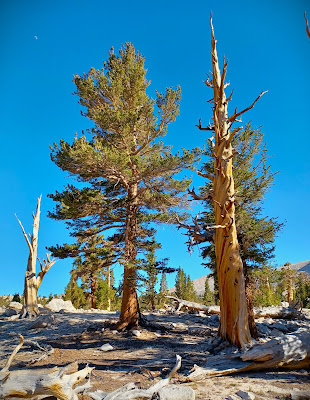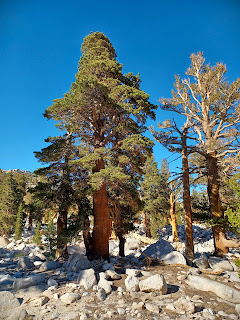Ascending Mount Langley: Reflections from the High Sierra - Part Five
By Armando Ortiz
Approaching the Final Stretch - Initial Reflections:
The trail changed as I descended. Rockslides had been cleared, and people had taken shortcuts. The way along the canyon face didn’t seem as stable as it had earlier in the morning when I climbed up. Now High and Long Lake looked like big rain puddles in the sunlight. Though it was a bit past three in the afternoon, it felt directly overhead, casting minimal shadows. I kept looking towards the boulder where my tent was, wondering if marmots had entered or nibbled a hole into the backpack.
Around that time a group of three or four were ascending the pass. We greeted each other and continued on our way. After about an hour the trail began to even out slightly. New Army Pass now seemed like a canyon of hightowers. More and more patches of green mossy grass came into view the lower the elevation it got. My steps going down were slow, but my body felt light. I scanned the trail below when suddenly my eyes saw wildflowers moving with delicate excitement as the breeze blew. Things were looking good. After reaching the foothill, I searched for my tent.
The tent was missing. As I approached the granite boulder, my green backpack came into view. Vexed, I stopped and looked around. It was packed, and under it was the tent. My eyes scanned the scene in confusion. Under the bag was a note that read,
“Hello, From the top of Army Pass, we saw your tent getting blown away down the mountain. We retrieved it 9000 years from your site and also found your sleeping bag a distance from your tent. We collapsed our tent and secured all your stuff (that we could find) with rocks. Your tent is damaged (torn a bit) I hope you didn't lose anything. Take care” - Jim
A sinking feeling inside hit like a flash as I simultaneously wondered, “why didn’t I pack my tent?” It could have taken 5-10 minutes at most getting everything packed. In the rush to summit the peak as early as possible, the tent not being as secure and anchored as it was supposed to be didn’t cross my mind.
This was a valuable learning experience. If I’d been on a multi day trip and had decided to summit a peak I’d be in trouble. Discovering that the tent was in tatters, the sleeping bag torn, and being 20-25 miles away from the car would have been trouble. My bear canister was where I’d left it, so I pulled it out and used it as a seat.
I reflected a bit on what had happened. As late afternoon approached, I scanned the area to ensure that nothing was missed by those that recovered my tent. Two aluminum stakes were still on the ground where I’d jammed them into the earth the night before. After making sure I’d scanned my area carefully, I paid attention to quickly inspecting the damage.
As I held the rainfly in my hands it looked like it had been attacked by an angry feral cat. The bottom of the tent was torn and scratched a bit, while the mesh area had one or two holes- it was no longer usable. The footprint was pretty much done. It was made of some type of flimsy plastic. The sleeping bag was ok, no visible sign of damage, maybe superficial scratches, but none that had gone through.
This set back definitely had me thinking for a bit, but my attention immediately went to reaching my car. I took a short break and gathered my thoughts. Everything seemed calm and quiet. I sat there, eating a granola bar and glanced at my watch. I could still get to my car with the afternoon light that remained. At a distance a marmot stood up to inspect the views. The lake was like a mirror and I was an audience to the sky. Looking around I realized I had set up camp in a place with lots of marmot activity. There were burrows and feces all around the boulder.
Reflecting on the situation, I realized that packing up the tent before leaving could have prevented damage and loss of stakes, ultimately avoiding a failed attempt to repair the damages. With these thoughts lingering, I ensured the area was clean before resuming my descent.
The pack felt heavy, and uncomfortable. I wanted to make it back to my car. Afternoon light was slowly turning into late afternoon shadows. The walk was steady, but I kept leaning slightly trying to give myself an impulse forward. I zigzagged my way through a foxtail pine grove with knotty branches. The gnarled trunks made them look really ancient. Red bark of these pines was contrasted by the evergreen bristles they held. I reached the Cottonwood Lakes around half past five in the afternoon.
Passing by the lakes different campsites were spotted. I thought of the two miles I could have saved in carrying the weight. My backpack kept loosening up. I stopped several times to adjust the straps. At times I’d wiggle my thumbs in between my front shoulders and the straps to relieve some of the pressure.
As the descent grew increasingly uncomfortable, I failed to realize that I had already hiked seventeen miles. The next five miles were slow, grinding and potentially dangerous. As I got closer to my destination it felt like I was carrying more than what I had started this adventure with. My pace was much slower, but the trekking poles kept their constant ticking sound.
Reaching the last five miles was a bit of relief, but at the same time began to feel greater discomfort. Here the air had seemed heavier and earthy. You could almost breathe in the greenery. Around six in the afternoon, a bit past mile twenty, and a few meters past the John Muir trail I ran into two backpackers that were beginning their week-long trek through the mountains. “Do the lakes have water?,” one of them asked. “Yes, but they were half full.” We all continued on our way. A tiny bit of jealousy did creep up while talking to them, hearing that they’d be up here much longer than I had. Their carrying load was definitely much more than mine. These encounters reminded me of the journey’s camaraderie, but also of the remaining distance ahead.
Despite nearing my car, the remaining three miles still seemed daunting. The trail was gradually flattening, but the ground was now soft, bordering on squishy. Every step I took seemed to make my feet sink into the fine gravel. I was tired. I’d stop, lean against a lodgepole, and the pack on its trunk. Its shiny bronze bark was rough. It was a relief to my back even if for a few seconds.
With each break there was a quick sip of water, and wiping the sweat from my eyes, and occasionally checking my watch. Then the trudge would resume. Although the air was still, the atmosphere was warm. I was sweating more. With every streak of sweat a thin white crust would build along my temples.
Things did get serious at one point. I began to have a dull pain in my knee, but I continued trugging. I struggled to stay synchronized with the poles and my steps. In the rush to get back to my car I pushed myself so much that by the time I was two miles away it became a trudge.
Although I still had the energy to continue my body had reached a point it had never experienced before. Yet, looking back now, all the hikes and training that took place can never prepare you for the challenges that an almost twenty one mile trek can take on the body. This is why it's important to never take long hikes that are considered difficult or strenuous lightly, but that one has to continuously train the body for those types of challenges.
Little by little, the loose ground made the last section uncomfortable and turned the sense of satisfaction into a restless desire to reach my final destination. As I traversed this flat section, it felt the most treacherous, with reaching my car looming as the biggest challenge at that moment. The trees were slowly being covered by the shade of the mountains, and the forest shadows were beginning to blend with the lifeless fallen trees. With determination fueled by the challenges overcome, I pressed onward towards the final stretch.


















